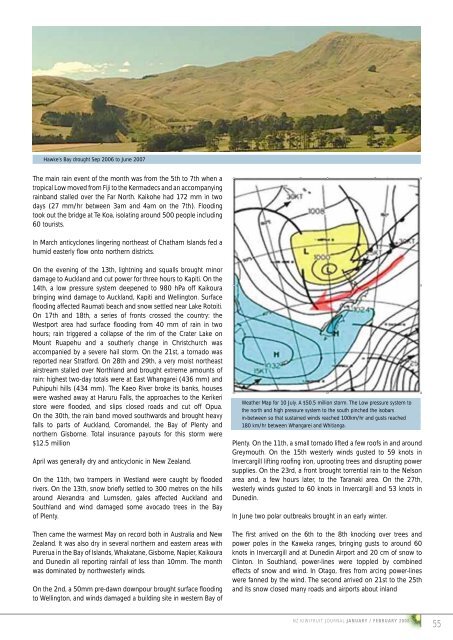Thirsty vines Summer girdling Compost teas Organic marketing The ...
Thirsty vines Summer girdling Compost teas Organic marketing The ...
Thirsty vines Summer girdling Compost teas Organic marketing The ...
You also want an ePaper? Increase the reach of your titles
YUMPU automatically turns print PDFs into web optimized ePapers that Google loves.
Hawke’s Bay drought Sep 2006 to June 2007<br />
<strong>The</strong> main rain event of the month was from the 5th to 7th when a<br />
tropical Low moved from Fiji to the Kermadecs and an accompanying<br />
rainband stalled over the Far North. Kaikohe had 172 mm in two<br />
days (27 mm/hr between 3am and 4am on the 7th). Flooding<br />
took out the bridge at Te Koa, isolating around 500 people including<br />
60 tourists.<br />
In March anticyclones lingering northeast of Chatham Islands fed a<br />
humid easterly fl ow onto northern districts.<br />
On the evening of the 13th, lightning and squalls brought minor<br />
damage to Auckland and cut power for three hours to Kapiti. On the<br />
14th, a low pressure system deepened to 980 hPa off Kaikoura<br />
bringing wind damage to Auckland, Kapiti and Wellington. Surface<br />
fl ooding affected Raumati beach and snow settled near Lake Rotoiti.<br />
On 17th and 18th, a series of fronts crossed the country: the<br />
Westport area had surface fl ooding from 40 mm of rain in two<br />
hours; rain triggered a collapse of the rim of the Crater Lake on<br />
Mount Ruapehu and a southerly change in Christchurch was<br />
accompanied by a severe hail storm. On the 21st, a tornado was<br />
reported near Stratford. On 28th and 29th, a very moist northeast<br />
airstream stalled over Northland and brought extreme amounts of<br />
rain: highest two-day totals were at East Whangarei (436 mm) and<br />
Puhipuhi hills (434 mm). <strong>The</strong> Kaeo River broke its banks, houses<br />
were washed away at Haruru Falls, the approaches to the Kerikeri<br />
store were fl ooded, and slips closed roads and cut off Opua.<br />
On the 30th, the rain band moved southwards and brought heavy<br />
falls to parts of Auckland, Coromandel, the Bay of Plenty and<br />
northern Gisborne. Total insurance payouts for this storm were<br />
$12.5 million<br />
April was generally dry and anticyclonic in New Zealand.<br />
On the 11th, two trampers in Westland were caught by fl ooded<br />
rivers. On the 13th, snow briefl y settled to 300 metres on the hills<br />
around Alexandra and Lumsden, gales affected Auckland and<br />
Southland and wind damaged some avocado trees in the Bay<br />
of Plenty.<br />
<strong>The</strong>n came the warmest May on record both in Australia and New<br />
Zealand. It was also dry in several northern and eastern areas with<br />
Purerua in the Bay of Islands, Whakatane, Gisborne, Napier, Kaikoura<br />
and Dunedin all reporting rainfall of less than 10mm. <strong>The</strong> month<br />
was dominated by northwesterly winds.<br />
On the 2nd, a 50mm pre-dawn downpour brought surface fl ooding<br />
to Wellington, and winds damaged a building site in western Bay of<br />
Weather Map for 10 July. A $50.5 million storm. <strong>The</strong> Low pressure system to<br />
the north and high pressure system to the south pinched the isobars<br />
in-between so that sustained winds reached 100km/hr and gusts reached<br />
180 km/hr between Whangarei and Whitianga.<br />
Plenty. On the 11th, a small tornado lifted a few roofs in and around<br />
Greymouth. On the 15th westerly winds gusted to 59 knots in<br />
Invercargill lifting roofi ng iron, uprooting trees and disrupting power<br />
supplies. On the 23rd, a front brought torrential rain to the Nelson<br />
area and, a few hours later, to the Taranaki area. On the 27th,<br />
westerly winds gusted to 60 knots in Invercargill and 53 knots in<br />
Dunedin.<br />
In June two polar outbreaks brought in an early winter.<br />
<strong>The</strong> fi rst arrived on the 6th to the 8th knocking over trees and<br />
power poles in the Kaweka ranges, bringing gusts to around 60<br />
knots in Invercargill and at Dunedin Airport and 20 cm of snow to<br />
Clinton. In Southland, power-lines were toppled by combined<br />
effects of snow and wind. In Otago, fi res from arcing power-lines<br />
were fanned by the wind. <strong>The</strong> second arrived on 21st to the 25th<br />
and its snow closed many roads and airports about inland<br />
NZ KIWIFRUIT JOURNAL JANUARY / FEBRUARY 2008<br />
55


